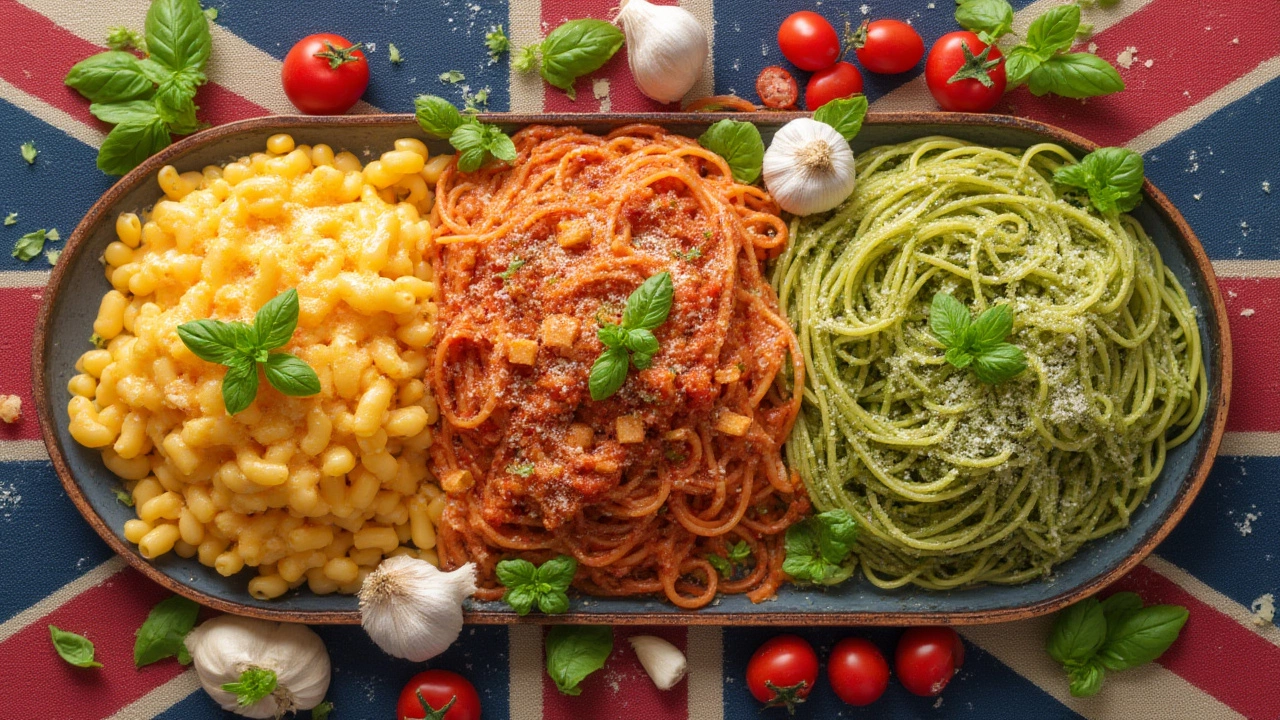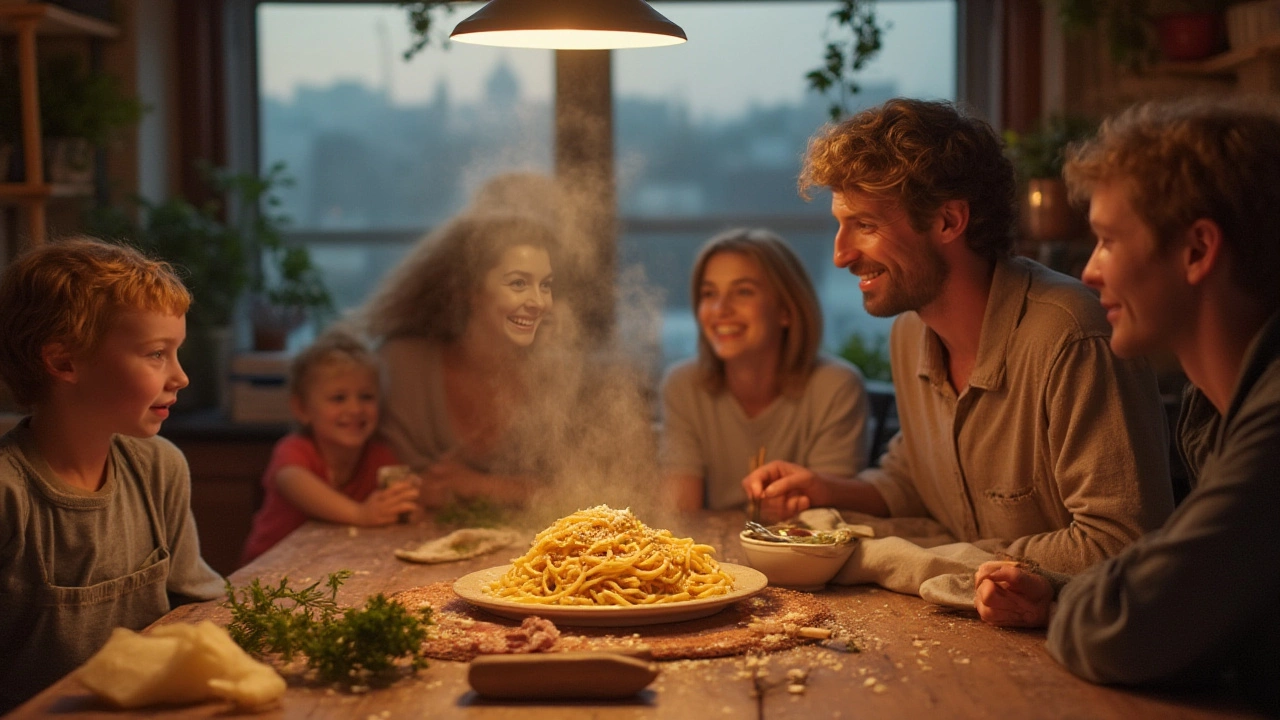If you ask ten people to name their favorite comfort food, there's a good chance at least half will mention something with pasta. There’s just something about a steaming plate of noodles, twirled graciously around a fork, that feels like home—whether you grew up with homemade sauce or a pantry staple from the store. The world of pasta is a glorious tangle of tradition and flavor, but three dishes seem to pop up everywhere, from modest kitchens to glossy restaurant menus: Spaghetti Carbonara, Lasagna, and Spaghetti Bolognese. People have been riffing on these recipes for decades, adding twists, sparking debates, and creating family rivalries over ‘the right way’ to do it. Let’s roll up our sleeves and get to know these three legends, along with some secrets about why they’ve stayed on top for so long.
Spaghetti Carbonara: The Creamy Classic That Isn’t Creamy
What’s wild about Spaghetti Carbonara is how often restaurants get it wrong. You see creamy sauces and even broccoli sneaking into some versions, but purists in Rome would faint at the thought—they’ll tell you Carbonara isn’t supposed to have a drop of cream. The original recipe calls for just a handful of ingredients: eggs, Pecorino Romano cheese, guanciale (that’s cured pork cheek, but in a pinch, pancetta works), and black pepper. That’s it. The magic lies in the timing: you toss hot pasta with raw eggs and cheese so the heat creates a silky sauce, not scrambled eggs. It’s simpler than it looks and way more satisfying.
One thing most folks don’t realize? Carbonara only became popular in Italy after World War II. Some culinary historians say it grew out of American soldiers giving out bacon and eggs during the liberation of Rome. The new flavors caught on, and locals found a way to blend these rations with their beloved spaghetti. Today, the dish has reached cult status. You can find it on menus in Paris, Tokyo, and New York, and there’s been a 30% uptick in global searches for ‘classic Carbonara recipe’ over the last five years.
Here’s a tip for perfect Carbonara: save a cup of the starchy pasta water before you drain the noodles. That little bit of salty water loosens the sauce and helps everything cling to the pasta. Don’t forget to use freshly cracked black pepper—it makes a difference you can taste.
| Ingredient | Classic Qty | Substitute |
|---|---|---|
| Guanciale | 150g | Pancetta, bacon |
| Pecorino Romano | 50g | Parmigiano Reggiano |
| Egg yolks | 4 | 2 whole eggs + 2 yolks |
| Spaghetti | 400g | Other pasta types |
| Black pepper | To taste | None |
Still hungry for Carbonara facts? Anthony Bourdain called it the "greatest thing in the history of the world." And according to a recent Italian food survey, Carbonara tops the list of most-ordered pasta dishes by travelers in Rome—beating Cacio e Pepe and Amatriciana.
Lasagna: Layered Comfort, Oven-Baked to Perfection
How many foods make you think of lazy Sunday family dinners or holidays surrounded by chatter and laughter? Lasagna might top that list. This dish probably dates back thousands of years—there are references to lasagna-like pasta even in Ancient Greece. Back then, it was nothing like the cheesy, saucy, layered masterpiece we know today, but everyone agrees this dish has deep roots.
Classic lasagna features layers of wide flat pasta, meat ragù, creamy béchamel, and enough cheese to please any crowd. Some say the key to a great lasagna is patience. You can’t just slap it together and hope for magic—the flavors get better as the layers rest together, and leftovers taste even richer on day two. In Emilia-Romagna, the ‘spiritual home’ of lasagna (at least according to locals), cooks use sheets of spinach pasta, slow-simmered Bolognese sauce, and rich béchamel. But cross the border into Naples, and you’ll find ricotta, small meatballs, and even hard-boiled eggs layered between the pasta.
Some stats to chew on: lasagna is the top-baked pasta dish worldwide, with America alone consuming over 15 million trays during the winter holiday season. On TikTok, the hashtag ‘lasagna’ has racked up over 1.2 billion views, thanks to cooks showing off epic cheese pulls and, sometimes, truly wild fusion takes.
Your best tip for top-notch lasagna? Let it sit after baking—at least 30 minutes. It holds its shape, slices cleanly, and the flavors settle in. Don’t skip covering it with foil for the first half of baking; this keeps the pasta moist before you let it brown up for that classic golden top.
- Use whole-milk ricotta for creamier layers (if your recipe calls for ricotta)
- Try a blend of mozzarella and Parmigiano for the cheese topping
- Homemade or store-bought fresh pasta sheets can give you a next-level texture
- Bake up to two days in advance and reheat gently—flavors deepen overnight
Not in the mood for meat? Veggie lasagna is just as much of a superstar. Spinach, eggplant, zucchini, and mushrooms all work well when roasted and layered in. Gluten-free versions aren’t hard to pull off either: several brands now offer lasagna sheets made from rice or corn blends.

Spaghetti Bolognese: The Meaty Mainstay That Isn’t Actually Italian
Most Italians will tell you: there’s no such thing as ‘Spaghetti Bolognese’ in their country. In Bologna, the home of ragù alla bolognese, the sauce comes with tagliatelle, not spaghetti. Still, this mashup—spaghetti covered in slow-cooked beef and tomato sauce—became so popular in the UK, US, and Australia that ‘Spag Bol’ is now staple comfort food worldwide.
What makes Bolognese the kind of dish you crave on cold nights? It’s all about the sauce, which bubbles away for hours until everything melts together. The classic version uses equal parts beef and pork, plus onions, carrots, celery, and just a touch of tomato. Milk or cream is often swirled in to mellow the acidity. The finished ragù should be thick, rich, and sticky enough to hug the pasta, not drippy and red like marinara. The International Academy of Italian Cuisine even registered the official ragù alla bolognese recipe in 1982—though plenty of grandmas still guard their own family secrets.
Spaghetti Bolognese is a Monday night hero for busy parents and students. In the UK, it’s reportedly on the dinner table at more than a quarter of households each week. Need to speed things up? You can make a solid Bolognese in under an hour if you brown the meat well and keep the sauce uncovered as it simmers to thicken up quickly.
Here are some Bolognese hacks you might not have heard:
- Don’t skip the soffritto (the diced onion, carrot, and celery base)—it’s non-negotiable
- Use a dash of Worcestershire sauce (yes, really) for an umami boost
- A splash of red wine gives depth, but let the alcohol cook off before adding the rest of the ingredients
- Finish with a grating of fresh Parmigiano over the top
Want to make it healthier? Lean ground turkey or even plant-based ‘meat’ works surprisingly well. Add a handful of chopped mushrooms for a big umami payoff—some restaurants in Milan have actually started offering vegetarian Bolognese that centers mushrooms, lentils, and walnuts. And if the purists call you out for using spaghetti, just smile and say you’re honoring the global spirit of pasta.
Choosing the Right Pasta Shape and Size for Your Sauce
Here’s a secret even some longtime cooks don’t know: the pasta shape can change everything. Each sauce pairs best with certain shapes, making a simple dinner taste restaurant-worthy. Take Carbonara—spaghetti is the classic, but some chefs prefer rigatoni or mezze maniche to help trap more sauce. Lasagna obviously requires wide flat sheets, but did you know some regions use thinner or thicker noodles depending on family tradition?
The science behind matching pasta and sauce isn’t just tradition—there’s a real reason to respect it. Long, thin noodles like spaghetti and linguine work well with slick, creamy sauces because they let the coating shine. Tube-shaped pastas like penne or rigatoni have grooves that grab chunky, meaty sauces like Bolognese. Wide, flat noodles (think tagliatelle or pappardelle) offer lots of surface area for thick ragùs. Here’s a quick guide:
| Pasta Shape | Best Sauce Match |
|---|---|
| Spaghetti | Creamy, oil-based |
| Tagliatelle | Meaty, chunky sauces |
| Rigatoni | Chunky, hearty ragù |
| Lasagne Sheets | Layered, baked |
| Penne | Vegetable-based or chunky sauces |
If you’re ever unsure, look for the sauce’s texture. Smooth, creamy, or runny sauces love the slender strands. Chunkier, heavier ragù needs a shape that can stand up to the heft. And always cook your pasta until just al dente, since it may cook a bit more in the sauce or oven. Nobody wants mushy noodles. If you care about authenticity but want to mix things up, it’s not a crime to swap shapes—just know the classic combos do exist for a reason.
Here’s a quirky fact for the trivia buffs: there are more than 300 recognized pasta shapes in Italy. Each is designed with a specific sauce or method in mind, and many come from small towns with their own beloved recipes and lore.

Tips for Cooking and Serving Pasta Like a Pro
You could have the world’s best Bolognese recipe and still mess up the meal if you fumble the basics. Nailing the perfect pasta dish means knowing a handful of kitchen secrets—the tricks that Italian home cooks use every night without even thinking. If you want your Spaghetti Carbonara or Lasagna to come out restaurant-worthy (or at least avoid sticky, flavorless noodles), keep these in mind:
- Salt your water generously—aim for the flavor of ‘salty tears’; it seasons the pasta throughout
- Don’t add oil to the water; it won’t keep noodles from sticking, but it will keep the sauce from clinging later
- Stir the pasta right after adding it to the pot—it helps prevent clumps
- Test for al dente a minute before the package time ends; pasta should have a bite, not crunch
- Always save some pasta water before draining; that starchy water is culinary gold for loosening and thickening sauces
- Toss the pasta with sauce over heat (not just dump it on top at the table)—it allows sauce to soak in and flavors to meld
- When baking (like with lasagna), let the dish rest before cutting; it’s less messy and tastes better
- Use fresh grated cheese for best texture and flavor—pre-grated can be drier or full of fillers
If you’re feeling adventurous, experiment with pasta made from chickpeas, lentils, or quinoa for a gluten-free take. And don’t overlook the leftovers—most pasta dishes reheat beautifully in the oven, covered with a splash of extra sauce or water to bring back moisture.
Here’s a breakdown of how long the top three pasta dishes keep in the fridge after cooking:
| Pasta Dish | Fridge Life (Days) |
|---|---|
| Spaghetti Carbonara | 1-2 |
| Lasagna | 3-4 |
| Spaghetti Bolognese | 3-4 |
Tired of reheating leftovers the same old way? Heat lasagna in the oven with a splash of broth and a tent of foil; reheat Carbonara gently on the stove with a touch of reserved pasta water to revive the sauce. And remember—pasta is more forgiving than you think. If your sauce separates, add more water. If your noodles stick, a quick rinse in hot water fixes it. Pasta night is about feeding people, not chasing perfection.
No matter what, these three pasta dishes keep winning hearts because they’re easy to love, fun to share, and endlessly adaptable. If you haven’t already tried them all, what are you waiting for? Grab your favorite pasta and get cooking—dinner’s never far away.

